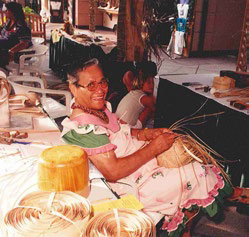Thankfully, in the late 1980s and 1990s, a new pride in Hawaiian traditions arose, and with it a new emphasis on the arts and crafts. In 1993, Auntie Elizabeth was named a Living Treasure by the Office of Hawaiian Affairs for her contributions to weaving. (Auntie was also instrumental in resurrecting the art of weaving makaloa, a reed that grows along the seashore, but which no one had used in weaving in 200 years.)
In addition to bringing pleasure to innumerous guests and visitors at Waikoloa Beach Resort, Auntie’s influence can still be felt through the many students she taught — many of whom have become kumu (teachers) in their own right — and the group she cofounded in 1996, Ka Ulu Lauhala o Kona. The group sponsors an annual workshop in Kona in May.
Although the tools used in the craft have evolved, the techniques Auntie taught are very similar to what was practiced in early Hawai‘i. The dried and gathered leaves have their thorny edges removed, pieces are torn into thin strips and cleaned, and a careful process of intertwining begins. Only today, instead of sails and roof thatching, modern weavers craft hats, purses, baskets, and placemats, much of it for collectors and an eager tourism market. “I love it,” Pohaku Kaho‘ohanohano, a master weaver and teacher of the craft on Maui, told Maui No Ka Oi Magazine in a 2013 interview, “because it’s part of my culture. I’m doing what my ancestors did. This is survival for me. It’s in my blood.”
Auntie Elizabeth would wholeheartedly agree. “Take care of the knowledge,” she said to her students in her last days. She can rest assured it is in good hands.

